

![]()
Ajmer was founded in the the 7th Century by Ajaipal Chauhan. Situated in valley amidst Aravali ranges, it derives the name from Ajaymeru (the invincible hill).
The harmonious blend of various religions and cultures has given a unique character to this pious land. This truly secular city is an excellent example of religious tolerance and brotherhood. Ajmer attracted Sufi saints, Hindu preachers, Jain munis, Parsee priests, Christian missionaries of all denominations ranging from the Church of England, Scottiish United free Church, American Methodists and Roman Catholics, Swami Dayanand Saraswati, the founder of Arya Samaj breathed his last in Ajmer. The Sikhs established Singh Sabha overthere.
The Chauhans dominated Ajmer till the end of the 12th century. Prithviraj Chauhan was the last great ruler, who was defeated at the hands of Muhammad Ghauri in 1193. Subsequently it was seized by Rana Kumbha of Mewar, then came the Muslim rulers of Malwa, who were thrown out by Maldeo Rathor of Marwar. Later on Akbar annexed it to the Mughal empire in 1556, and made it the headquarters for the operations in Rajputana and Gujrat. From 1818 onwards it came under the domain of British empire, after concluding a treaty with Daulat Rao Scindia, the Maratha chief. The British left behind a legacy of excellent educational institutions as they found Ajmer to be an ideal location.
Ajmer is associated with many important historical events. Sir Thomas Roe, the ambassador of King James 1 of England presented his credentials to Jehangir here on 10th Jan 1616. Dara Shikoh, the eldest son of Shah Jahan was born here, and the war of succession between the sons of Shah Jahan was won 1659 by Auranzeb in the battle of Dorai near Ajmer.
Ajmer is an oasis wrapped in the green hills. The city was founded by Raja Ajay Pal Chauhan in the 7th Century A.D. Situated in a valley amidst Aravali ranges, it derives the name from Ajayameru (the invincible Hill) and continued to be a major centre of the Chauhan power till 1193 A.D. When Prithviraj Chauhan lost it to Mohammed Ghauri. Since then, Ajmer became home to many dynasties. Today,
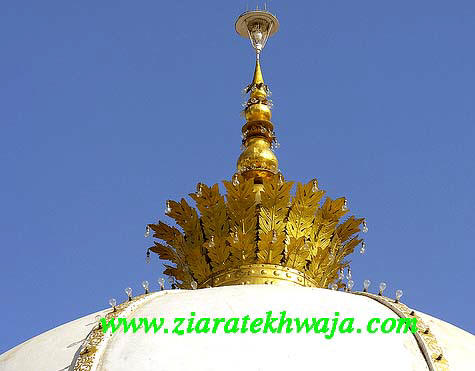
Ajmer is a popular
pilgrimage centre for the Muslims as well as Hindus. Especially famous is the
DARGAH Sharif-tomb of the Sufi saint Khwaja Syed Moinuddin
Chishty, which is
equally revered by the Muslims and Hindus. It is a centre of culture and
education, the British chose Ajmer for its prestigious Mayo College a school
exclusively for Indian nobility. Ajmer is also the base for visiting Pushkar (11
km.), the abode of Lord Brahma, lying to its west with a temple and a
picturesque lake. The Pushkar Lake is a sacred spot for Hindus. During the month
of Kartik (Oct./Nov.), devotes throng in large numbers here to take a dip in the
sacred lake.
Ajaipal Chauhan founded
Ajmer in the seventh century. He constructed a hill fort "Ajaimeur" or the
invincible hill. The Chauhans ruled Ajmer till the 12th century when Prithviraj
Chauhan lost Mohammed Ghauri. Thereafter it became a part of the sultanate of
Delhi. Ajmer was also favorite residence for the great Mughals. One of the first
contacts between the Mughal King Jahangir and Sir Thomas Roe took place here in
1616. The Scindias took over the city in 1818 and then handed it over to the
British and it became one of the only part of Rajasthan controlled directly by
the East Indian Co. The bus stand in Ajmer is located near the RTDC hotel
Khadim. And the railway is further north and most of the hotels are west of the
stations. Northeast is the main post office and most of the cities market is
located behind and up to Agra Gate. Further north is a large artificial lake
called the Anna Sagar. Climate Pretty hot in summers and becomes green with
first rain as all its small mountains become green, in winters temperature is
chilled.
The nearest airport is that of Jaipur. But the city is well connected by trains and the buses with all the major places in India. The state transport has its bus services from all over Rajasthan and also from Delhi. However, during the Urs large number of people arriving in Ajmer it is advisable to plan your trip in advance during this extraordinary time.
|
Air: |

|
Rail |

|
Road |
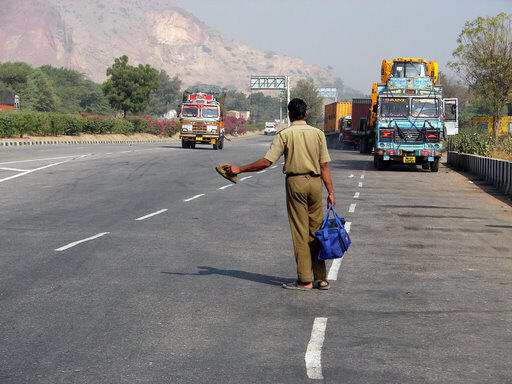
|
ROAD DISTANCE TO SOME IMPORTANT PALACES FROM AJMER: Ahmedabad :570 km. Via Pali, Sirohi. Agra :360 km. Via Jaipur,.Bharatpur. Delhi : 395 km. via Jaipur, Behror. Jaipur : 131 km. via Kishangarh, Dudu Mount Abu : 377 km via Bar, Pali, Sirohi. Udaipur : 302 km via Chittaurgarh. Jodhpur : 198 km via Bar, Jaitaran, Bilara.
|
|
Dargah Dargah is 10 Minutes from Railway Station 15 Minutes from Bus Stand. |
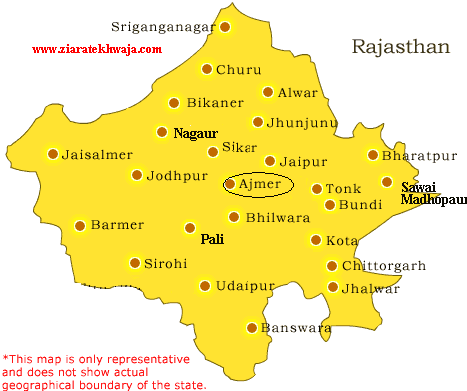
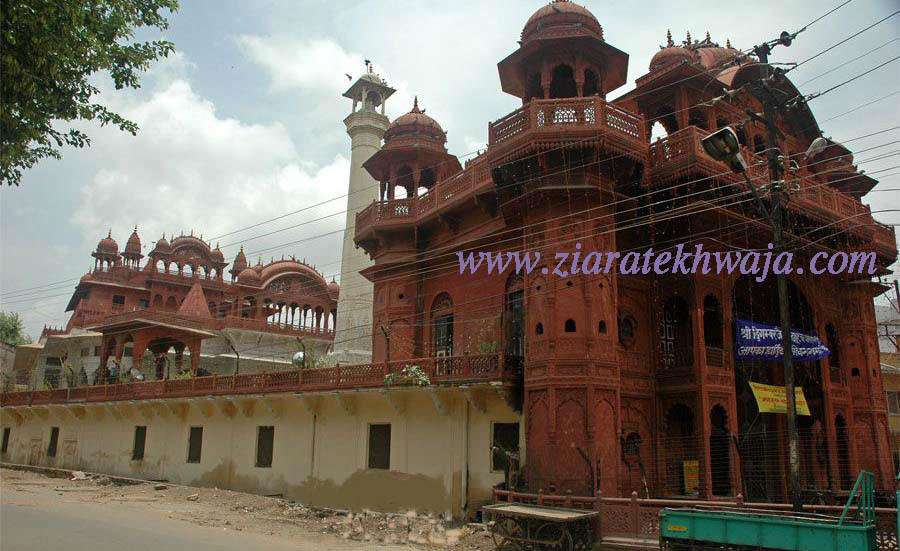
The red temple is a Digambar Jain temple which has a double- storey hall adjacent to the main temple. The hall displays a series of large gold plated wooden figures depicting legends from Jain mythology. The entire hall is richly adorned by glass mosaic, precious stones, gold and silver work. The place is also popularly called Soni Ji Ki Nasiyan.
Once the royal residence of Emperor Akbar, the museum houses a rich
repository of the Mughal and Rajput armor and exquisite sculptures.
![]()
On the north-eastern side of Sada Bahar hill is located the Chillah of Hazrat Khwaja Qutubuddin Bakhtiyar Kaki (R.A.). It is the place where Hazrat engaged himself in prayers when in Ajmer.
![]()
Shahjahan built buildings of white marbles on eastern bank of Anna Sagar. There is a very beautiful "Baradari". Amid these buildings and on the eastern side of it is located a beautiful green garden named Daulat Bagh. Its name has now been changed to Subhash bagh.
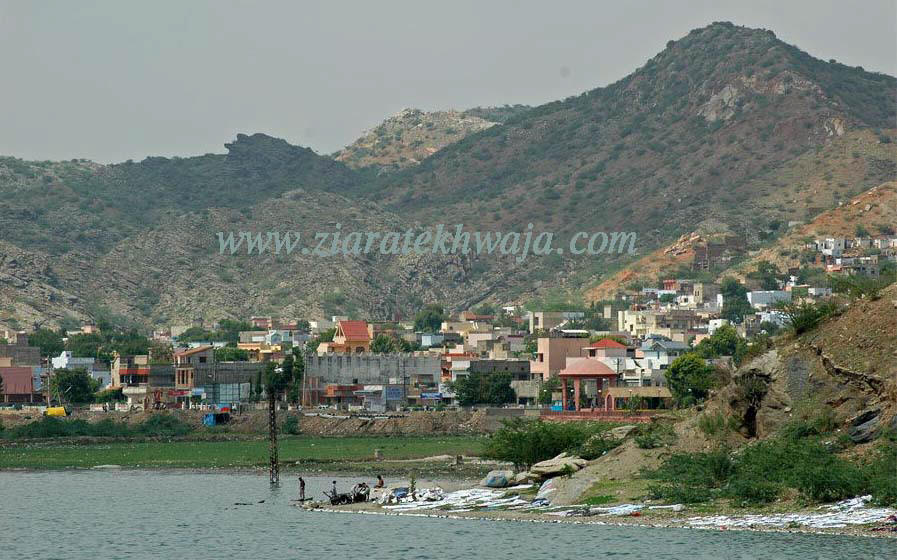

It is an artificial lake named after Anaji Chauhan. The catchments were built with the help of local populace. The 'Baradari' pavilions was built by Shah Jahan, to facilitate his long stays in Ajmer. the Baradari and the adjoining parks are the lungs of city and favourite outing spot
![]()
The Chillah of Hazrat Syed Badiuddin Qutubul Madar Shah Makanpuri (R.A.) is located on the hills of eastern side of Ajmer at a height of some 700ft. Urs is celebrated here on 18th of Jamadi-ul-Awwal. The mazar of Hazrat Shah Madar (R.A.) is situated in Makanpur.
.jpg)
![]()
Dhai Din Ka Jhonpra or Dhai Din ki Masjid is a grand mosque made of red stone and located at a high place. Sultan Shamsuddin Altmash got it repaired and made some modification. One can reach the building if starts from Dargah Bazar to west along the bound aryl wall of Dargah Sharif. After crossing Tirpolia Gate (Darwaza), there is Mohalla Anderkot. At a short distance from Anderkot this mosque is located on right hade side.
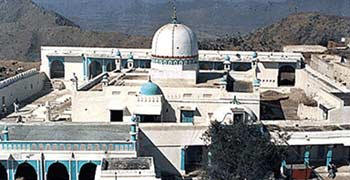
![]()
The giant fort stands guarding the city. It has six
gates. The fort also has Miran Saheb ki Dargha who was the governor of the fort
and laid down his life in an encounter. It gives a panoramic view of the city
situated in Nagpahari of Aravalli ranges, this fort has immense archaeological
and historical importance.
It is a grand fort, located on a steep hill in south of Dargah Sharif. The height of the hill is 800ft. During the reign of Rai Pithora, it was a famous and strong fort and was considered that it can not be conquered. But Sultan Shahabuddin Ghauri conquered it without any difficulty and appointed Syed Meeran Hussain (R.A.) as the Garrison Commander (Qiledaar).
NIGHT ATTACK ON TARAGARH
During the reign of Qutubuddin Ebak, Syed Meeran Hussein (R.A.) was the Garrison Commander of Taragarh Fort. He also lived in the fort. While playing polo in Lahore, Sultan Qutubuddin Ebak feel down from the back of the horse and died. As soon as the news of this death reached Ajmer, the Thakur and Rajput landlords of adjoining areas jointly launched a night attack on Taragarh and entered the fort. It was totally dark and the Muslims were sleeping unaware. Most of them were slashed. Rest of them were awaken in a panic and started resisting. But they were smaller in number than the powerful break of the day. Meeran Husain Khunak Sarwar (R.A.) was also martyred in the attack.
When the Muslims of the city heard the news of the bloodshed there was a mass mourning knowing about the tragedy, Khwaja Gharib Nawaz visited the fort with his followers and after the Namaz-e-Janaza, burrid the martyrs of Taragarh. Presently the ruins of the fort are left, but however everyone visits the Dargah of Hazrat Meeran Husain Khunak Sarwar (R.A.) to pay the tributes.
Hazrat Syed Meeran Husain (R.A.) was a great abstemious saint. He mostly used to be at the service of Gharib Nawaz (R.A.) as a staunch follower. His Urs falls on 17th and 18th of Rajab every year.
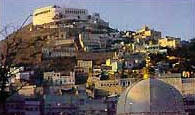
![]()
On the top of a hill in the south of Dargha Sharif is a green colored tomb. It is said that a brick of holy Mazar of Hazrat Piran-e-Pir Dastagir (R.A.) is buried. That is why the place is famous as Chillah Bare Pir Sahib, otherwise Hazrat Piran Pir (R.A.) never came of India.